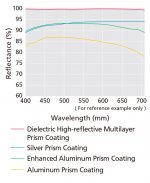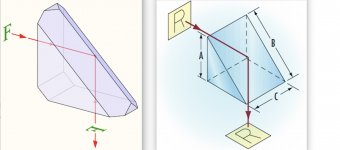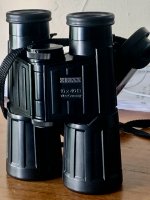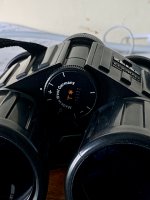John A Roberts
Well-known member

Swarobright
Swarobright is Swarovski's brand name for dielectric prism coating.
It's a multiple layer coating that's used on the non-total internal reflection surface found on most roof prisms
i.e. it acts as a mirror.
So it's needed on both Schmidt-Pechan and Uppendahl prisms, but not on Abbe-Koenig ones
(for information on various roof prisms that have been used in binoculars, see post #32 and on at: New Horizons II ).
Dielectric coating was introduced in roof prism binoculars by Zeiss in 1998, and was then quickly adopted by other manufacturers.
It gives more vibrant colours and minimises the tendency to a yellowish image that was common to previous coatings.
Previous coatings used in terms of decreasing reflective efficiency were silver, aluminium and stainless steel *
All were deficient in terms of the blue portion of the colour spectrum, and so resulted in a slight yellow tint to the reflected image.
* See attached below an image from Nikon, showing the reflectance of various mirror coatings, from: Nikon | Sport Optics | Coating on roof (Dach) prism)
In relation to optical coatings, a dielectric coating is distinct from a metallic one. It uses interference to change the reflectance of a coated surface.
For an explanation and diagrams see: Dielectric Coatings
On binocular prisms, a large number of coating layers are used, to achieve the cumulative effect of reflecting the entire visible spectrum.
A Swarovski image from 2008 indicates that 30 layers were then used on the SLC 7x42.
However, since then the number of layers used has increased significantly e.g. Zeiss currently uses over 70 layers,
as indicated in the screen grab from: About Binoculars: Complex Design - ZEISS Hunting
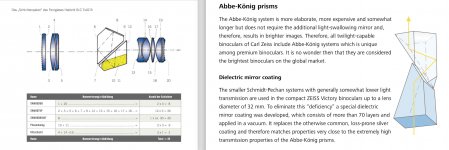
Swarobright was progressively introduced across the various Swarovski roof prism product lines starting in late 1998.
In relation to binoculars:
• it was first used on two of the SLC models in late 1998;
• but not on the Pocket models and EL models until late 2001.
The staggered introductions on the SLC series, imply that the coatings needed to be tuned for each particular model.
n.b. Swarobright was not on the original EL x42 series from its introduction in mid-1999, as is indicated below,
and also in a 2010 thread: Lense coatings on old EL 8.5x42?
In relation to telescopes in 1998:
• the AT/ ST Porro prism series didn’t need the coating, and; the ATS/ STS Schmidt-Pechan prism series introduced in 2002 has Swarobright.
• the CT series of draw tube telescopes didn't have Swarobright coating, but; the CTC 75 introduced in 2001 and the CTS 85 in 2003 both have Swarobright.
(The earlier AZF series of draw tube telescopes from 1967 to 1993 used Abbe-Koening prisms, and so didn't need a mirror coating.)
Swarobright is Swarovski's brand name for dielectric prism coating.
It's a multiple layer coating that's used on the non-total internal reflection surface found on most roof prisms
i.e. it acts as a mirror.
So it's needed on both Schmidt-Pechan and Uppendahl prisms, but not on Abbe-Koenig ones
(for information on various roof prisms that have been used in binoculars, see post #32 and on at: New Horizons II ).
Dielectric coating was introduced in roof prism binoculars by Zeiss in 1998, and was then quickly adopted by other manufacturers.
It gives more vibrant colours and minimises the tendency to a yellowish image that was common to previous coatings.
Previous coatings used in terms of decreasing reflective efficiency were silver, aluminium and stainless steel *
All were deficient in terms of the blue portion of the colour spectrum, and so resulted in a slight yellow tint to the reflected image.
* See attached below an image from Nikon, showing the reflectance of various mirror coatings, from: Nikon | Sport Optics | Coating on roof (Dach) prism)
In relation to optical coatings, a dielectric coating is distinct from a metallic one. It uses interference to change the reflectance of a coated surface.
For an explanation and diagrams see: Dielectric Coatings
On binocular prisms, a large number of coating layers are used, to achieve the cumulative effect of reflecting the entire visible spectrum.
A Swarovski image from 2008 indicates that 30 layers were then used on the SLC 7x42.
However, since then the number of layers used has increased significantly e.g. Zeiss currently uses over 70 layers,
as indicated in the screen grab from: About Binoculars: Complex Design - ZEISS Hunting

Swarobright was progressively introduced across the various Swarovski roof prism product lines starting in late 1998.
In relation to binoculars:
• it was first used on two of the SLC models in late 1998;
• but not on the Pocket models and EL models until late 2001.
The staggered introductions on the SLC series, imply that the coatings needed to be tuned for each particular model.
n.b. Swarobright was not on the original EL x42 series from its introduction in mid-1999, as is indicated below,
and also in a 2010 thread: Lense coatings on old EL 8.5x42?
In relation to telescopes in 1998:
• the AT/ ST Porro prism series didn’t need the coating, and; the ATS/ STS Schmidt-Pechan prism series introduced in 2002 has Swarobright.
• the CT series of draw tube telescopes didn't have Swarobright coating, but; the CTC 75 introduced in 2001 and the CTS 85 in 2003 both have Swarobright.
(The earlier AZF series of draw tube telescopes from 1967 to 1993 used Abbe-Koening prisms, and so didn't need a mirror coating.)
Attachments
Last edited:




